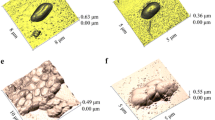Abstract
Escherichia coli B/5 12-h cultures were exposed to filter-sterilized acid mine water (AMW), fixed in situ, and examined for morphological changes by transmission electron microscopy, scanning electron microscopy, and x-ray spectrometry. Thin sections showed that layers of the Gram-negative envelope were altered and often lacking. Additionally, polar regions of the cell were frequently devoid of cytoplasm. AMW-exposed cells were distorted and had an amorphous substance associated with them. Spectra obtained by x-ray spectrometry suggested that this amorphous substance was cytoplasm rather than a mineral precipitate from AMW. Morphometric analyses of control and AMW-exposed populations showed significant differences in mean volume, length, and width of cells stressed in AMW; this indicates that smaller cells were selectively destroyed by the action of AMW. We concluded that loss of cytoplasm and cell lysis were the consequence of AMW damage to the bacterial envelope.
Similar content being viewed by others
Literature Cited
Ahmadian S, Ulrich R, Buthala DA (1979) Cell culture contaminants detected by transmission electron microscopy of surface replicas. Micron 10:273–275
American Public Health Association (1980) Standard methods for the examination of water and wastewater, 15th edn. Washington DC: American Public Health Association
Cullum J, Vincente M (1978) Cell growth and length distribution inEscherichia coli. J Bacteriol 134:330–337
Davis BD (1980) Microbiology, 3rd edn. Hagerstown MD: Harper and Row
Dixon WJ, Massey FJ Jr (1969) Introduction to statistical analysis. New York: McGraw-Hill
Double ML, Bissonnette GK (1980) Enumeration of coliforms from streams containing acid mine water. J Water Pollut Control Fed 52:1947–1952
Hackney CR, Bissonnette GK (1978) Recovery of indicator bacteria in acid mine streams. J Water Pollut Control Fed 50:775–780
Jolliffe LK, Doyle RJ, Streips UN (1981) The energized membrane and cellular autolysis inBacillus subtilis. Cell 25:753–763
Kellenberger E, Ryter A, Sechaud J (1958) Electron microscope study of DNA-containing plasms. II. Vegetative and mature phage DNA as compared with normal bacterial nucleotides in different physiological states. J Biophys Biochem Cytol 4:671–678
Kim AG, Heisey BS, Kleinmann RLP, Deul M (1982) Acid mine water drainage: control and abatement research. US Bureau of Mines Information. Circular 8905 Washington DC, 22 pp
Koppes LJH, Meyer M, Oonk HB, De Jong MA, Nanninga N (1980) Correlation between size and age at different events in the cell division cycle ofEscherichia coli. J Bacteriol 143:1241–1252
Mitchell P, Moyle J (1956) Osmotic function and structure in bacteria. In: Spooner ETC, Stocker BAD (eds) Symposium of the Society for General Microbiology, vol 6. London: Cambridge University Press, pp. 150–180
Ray B, Speck ML (1973) Freeze-injury in bacteria. CRC Crit Rev Clin Lab Sci 4:161–213
Reynolds ES (1963) The use of lead citrate at high pH as an electron-opaque stain in electron microscopy. J Cell Biol 17:208–212
Rogers TO, Wilson HA (1966) pH as a selecting mechanism of the microbial flora in wastewater-polluted acid mine drainage. J Water Pollut Control Fed 38:990–995
Trueba FJ, Woldringh CL (1980) Changes in cell diameter during the division cycle ofEscherichia coli. J Bacteriol 142:869–878
Tuttle JH, Dugan PR, Apel WA (1977) Leakage of cellular material fromThiobacillus ferrooxidans in the presence of organic acids. Appl. Environ Microbiol 33:459–469
Walsh F (1978) Biological control of mine drainage. In: Mitchell R (ed) Water pollution microbiology, vol 2. New York: John Wiley and Sons, pp. 337–389
Warburg O, Christian W (1942) Isolierung ung Kristallisation des Gärungsferments Enolase. Biochem Z 310:384–421
Woldringh CL, De Jong MA, Van den Berg W, Koppes L (1977) Morphological analysis of the division cycle of twoEscherichia coli substrains during slow growth. J Bacteriol 131:270–279
Wortman AT, Bissonnette GK (1985) Injury and repair ofEscherichia coli damaged by exposure to acid mine water. Water Res 19:1291–1297
Author information
Authors and Affiliations
Rights and permissions
About this article
Cite this article
Wortman, A.T., Voelz, H., Lantz, R.C. et al. Effect of acid mine water onEscherichia coli: Structural Damage. Current Microbiology 14, 1–5 (1986). https://doi.org/10.1007/BF01568093
Issue Date:
DOI: https://doi.org/10.1007/BF01568093




